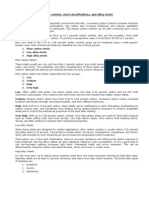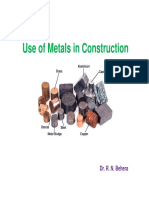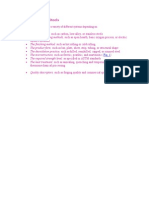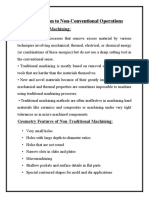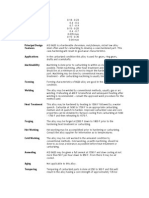0 ratings0% found this document useful (0 votes)
143 viewsFerrous Metals and Alloys
Ferrous Metals and Alloys
Uploaded by
LeonardDacaymatThis document provides background information on metals and categorizes different types of metals. It begins by explaining that metals are naturally occurring elements that are extracted from the earth's crust as metal ores. It then categorizes metals into ferrous and non-ferrous metals. The majority of the document focuses on describing various ferrous metals including steel alloys like carbon steels, alloy steels, stainless steels and more. It provides details on their compositions, properties and common applications.
Copyright:
© All Rights Reserved
Available Formats
Download as PPTX, PDF, TXT or read online from Scribd
Ferrous Metals and Alloys
Ferrous Metals and Alloys
Uploaded by
LeonardDacaymat0 ratings0% found this document useful (0 votes)
143 views44 pagesThis document provides background information on metals and categorizes different types of metals. It begins by explaining that metals are naturally occurring elements that are extracted from the earth's crust as metal ores. It then categorizes metals into ferrous and non-ferrous metals. The majority of the document focuses on describing various ferrous metals including steel alloys like carbon steels, alloy steels, stainless steels and more. It provides details on their compositions, properties and common applications.
Original Description:
ferrous metals and alloys
Copyright
© © All Rights Reserved
Available Formats
PPTX, PDF, TXT or read online from Scribd
Share this document
Did you find this document useful?
Is this content inappropriate?
This document provides background information on metals and categorizes different types of metals. It begins by explaining that metals are naturally occurring elements that are extracted from the earth's crust as metal ores. It then categorizes metals into ferrous and non-ferrous metals. The majority of the document focuses on describing various ferrous metals including steel alloys like carbon steels, alloy steels, stainless steels and more. It provides details on their compositions, properties and common applications.
Copyright:
© All Rights Reserved
Available Formats
Download as PPTX, PDF, TXT or read online from Scribd
Download as pptx, pdf, or txt
0 ratings0% found this document useful (0 votes)
143 views44 pagesFerrous Metals and Alloys
Ferrous Metals and Alloys
Uploaded by
LeonardDacaymatThis document provides background information on metals and categorizes different types of metals. It begins by explaining that metals are naturally occurring elements that are extracted from the earth's crust as metal ores. It then categorizes metals into ferrous and non-ferrous metals. The majority of the document focuses on describing various ferrous metals including steel alloys like carbon steels, alloy steels, stainless steels and more. It provides details on their compositions, properties and common applications.
Copyright:
© All Rights Reserved
Available Formats
Download as PPTX, PDF, TXT or read online from Scribd
Download as pptx, pdf, or txt
You are on page 1of 44
At a glance
Powered by AI
The key takeaways are that metals are naturally occurring elements found in the earth's crust that need to be extracted and processed before use. The document discusses the background and categories of metals including ferrous and non-ferrous metals as well as the extraction and processing of iron.
The different categories of metals discussed are ferrous metals, which contain iron, and non-ferrous metals, which do not contain iron.
Iron is extracted from its ore through a process called smelting, which involves heating the iron ore in a furnace to separate the pure iron.
Presented by:
Benliro, Chin chin Pearl
Dacaymat, Leonard
Perez, Edmar
Vivas, Jean
Background on metals
The elements of all metals are found naturally
in the earth. However, they need to be extracted
and processed before they can be used for
manufacturing purposes. Because metals in their
most basic form are natural resources,. Metals
form part of the earths crust as metal ore. To
obtain useful metals, the metal ore is mined and
washed to remove other minerals and unwanted
materials. Iron ore is the basis for most steels. To
extract pure iron the iron ore is heated in a furnace
in a process known as smelting.
SMELTING
Categories of metals
Ferrous
metals
Non
Ferrous
metals
Iron
a soft, silvery metal that is the
fourth most abundant element in the
Earths crust. Pure iron is unobtainable
by smelting, but small amounts of
impurities can make iron many times
stronger than it exists in its pure form.
Ferrous Metals
Ferrous facts
Iron replaced bronze as
the principal metal by
1000 BC.
Early pots and pans made
from iron poisoned the
users!
Early steels were made by
adding carbon to iron as
it was melted over a
charcoal fire.
Ferrous metals:
contain iron
will corrode unless
protected
are attracted by a
magnet
are strong, rigid
and cheap.
Ferrous Metals
Ferrous metals are produced in larger quantities
than any other metallic material. Three factors account
for it:
availability of abundant raw materials combined with
economical extraction
ease of forming
their versatile mechanical and physical properties.
Ferrous metals have some disadvantages, includes:
poor corrosion resistance
Ferrous Metals & alloys
relatively high density
low electrical and thermal conductivities
Alloy
Sometimes ferrous and non-ferrous metals
require different properties in order to function better
in specific situations. Alloying metals involves mixing
two or more metals and other elements to improve
their properties.
Ferrous Metals and Alloys
Alloying metals can:
lower the melting point
alter thermal and electrical properties
make a material harder for cutting purposes
improve resistance to corrosion
help metal to flow better into a cast.
Ferrous Alloys
Ferrous Alloys
Ferrous Alloys
-Alloys containing Iron as the main element.
-The most important ferrous alloy system (Fe-C system)
-Alloys of this system can be further divided into steels
and cast irons.
-Then, all steels solidify into a single -Fe structure first
and then experience the complex eutectoid reaction.
Therefore, heat treatment processes, which alter the
eutectoid reaction, are vitally important for controlling
microstructure and properties of steels.
Ferrous Alloys
Another classification is made based on their
formability. If materials are hard to form, components
with these materials are fabricated by casting, thus
they are called cast alloys. If material can be
deformed, they are known as wrought alloys.
Materials are usually strengthened by two methods
cold work and heat treatment. Strengthening by heat
treatment involves either precipitation hardening or
martensitic transformation, both of which constitute
specific heat treating procedure. When a material can
not be strengthened by heat treatment, it is referred as
non-heat-treatable alloys.
Alloying Elements
Manganese
Nickel
Silicon
Chromium
Molybdenum
Vanadium
Tungsten
Improves hardness and toughness
Improves hardness
Improves toughness, shock resistance and
strength
Allows steel to be cut at high strength
Increases strength and toughness of heat-
treated steel
Increases strength and toughness in low
temperature
Increases resistance to wear and tear,
improves durability
Classification of terms
Steels
Steels are alloys of iron and carbon plus other
alloying elements. In steels, carbon present in atomic
form, and occupies interstitial sites of Fe
microstructure. Mechanical properties of steels are
very sensitive to carbon content. Hence, it is practical
to classify steels based on their carbon content.
Steels - the ferrous alloys with less than 2.14% C
Cast Irons - the ferrous alloys with higher than 2.14% C
Steels
Steels are basically two kinds:
low-carbon steels (% wt of C < 0.3)
medium carbon steels (0.3 <% wt of C < 0.6)
high-carbon steels (% wt of C > 0.6)
1. (plain) Carbon steels
2. Alloy steels
low alloy (< 5 % total alloying element)
high alloy (> 5% total alloying element)
Carbon Steel
Carbon steel is a malleable, iron-based metal
containing less than 2% carbon (usually less than 1%),
small amounts of manganese, and other trace
elements. Steels can either be cast to shape or wrought
into various mill forms from which finished parts are
formed, machined, forged, stamped, or otherwise
shaped. Carbon steels are specified by chemical
composition, mechanical properties, method of
deoxidation, or thermal treatment.
Microscopic structure of Carbon steel
Low Carbon Steels
These are arguably produced in the greatest
quantities than other alloys. Carbon present in these
alloys is limited, and is not enough to strengthen these
materials by heat treatment; hence these alloys are
strengthened by cold work. Their microstructure
consists of ferrite and pearlite, and these alloys are
thus relatively soft, ductile combined with high
toughness. Hence these materials are easily
machinable and weldable. Typical applications of
these alloys include: structural shapes, tin cans,
automobile body components, buildings, etc.
Medium Carbon Steels
These are stronger than low carbon steels. However
these are of less ductile than low carbon steels. These alloys
can be heat treated to improve their strength. Usual heat
treatment cycle consists of austenitizing, quenching, and
tempering at suitable conditions to acquire required
hardness. They are often used in tempered condition. As
hardenability of these alloys is low, only thin sections can
be heat treated using very high quench rates. Ni, Cr and Mo
alloying additions improve their hardenability. Typical
applications include: railway tracks & wheels, gears, other
machine parts which may require good combination of
strength and toughness.
High Carbon Steels
These are strongest and hardest of carbon steels,
and of course their ductility is very limited. These are
heat treatable, and mostly used in hardened and
tempered conditions. They possess very high wear
resistance, and capable of holding sharp edges. Thus
these are used for tool application such as knives,
razors, hacksaw blades, etc. With addition of alloying
element like Cr, V, Mo, W which forms hard carbides
by reacting with carbon present, wear resistance of
high carbon steels can be improved considerably.
Alloy Steels
Steels that contain specified amounts of alloying
elements -- other than carbon and the commonly accepted
amounts of manganese, copper, silicon, sulfur, and
phosphorus -- are known as alloy steels. A steel is
considered to be an alloy when the maximum of the range
given for the content of alloying elements exceeds one or
more of these limits: 1.65% Mn, 0.60% Si, or 0.60% Cu; or
when a definite range or minimum amount of any of the
following elements is specified or required within the
limits recognized for constructional alloy steels: aluminum,
chromium (to 3.99%),
Alloy Steels
cobalt, columbium, molybdenum, nickel, titanium,
tungsten, vanadium, zirconium or other element
added to obtain an alloying effect. Technically, then,
tool and stainless steels are alloy steels.
High - Strength low - alloy
A special group of ferrous alloys with noticeable
amount of alloying additions are known as HSLA
(high-strength low-alloy) steels. Common alloying
elements are: Cu, V, Ni, W, Cr, Mo, etc. These alloys
can be strengthened by heat treatment, and yet the
same time they are ductile, formable. Typical
applications of these HSLA steels include: support
columns, bridges, pressure vessels.
Stainless steels
The name comes from their high resistance to
corrosion i.e. they are rust-less (stain-less). Steels are
made highly corrosion resistant by addition of special
alloying elements, especially a minimum of 12% Cr
along with Ni and Mo. Stainless steels are mainly three
kinds: ferritic & hardenable Cr steels, austenitic and
precipitation hardenable (martensitic, semi-
austenitic) steels. This classification is based on
prominent constituent of the microstructure. Typical
applications include cutlery, razor blades, surgical
knives, etc.
Stainless Steels: kinds
Ferritic stainless steel
Ferritic stainless steels are principally Fe-
Cr-C alloys with 12-14% Cr. They also contain
small additions of Mo, V, Nb, and Ni.
Austenitic Stainless Steel
Austenitic stainless steels usually contain 18% Cr
and 8% Ni in addition to other minor alloying
elements. Ni stabilizes the austenitic phase assisted by
C and N. Other alloying additions include Ti, Nb, Mo
(prevent weld decay), Mn and Cu (helps in stabilizing
austenite).
Stainless Steels: kinds
Martensitic stainless steels, typified by types
410/420/440, containing about 12Cr and 0.1C wt% as
the basic composition. They are not as corrosion
resistant as the other classes, but are extremely strong
and tough as well as highly machineable, and can be
hardened by heat treatment. They contain 11.5 to 18%
chromium and significant amounts of carbon. Some
grades include additional alloying elements in small
quantities.
Martensitic stainless steel
Stainless Steels: kinds
Duplex stainless steels are two-phase alloys based
on the Fe-Cr-Ni system. The specific advantages offered by
duplex stainless steels over conventional 300 series
stainless steels are strength (approximately twice that of
austenitic stainless steels), improved toughness and
ductility (compared to ferritic grades), and a superior
chloride SCC resistance and pitting resistance. The high
yield strength offers designers the use of thin-wall material
(which can lead to major reductions in weight) with
adequate pressure-containing and load-bearing capacity.
Duplex stainless steels have found widespread use in a
range of industries, particularly the oil and gas,
petrochemical, and pulp and paper industries.
Tool Steels
Tool steels are particular steels designed for being
made into tools. They are known for toughness,
resistance to abrasion, ability to hold a cutting edge,
and/or their resistance to deformation at high
temperatures. The three types of tool steel available
are cold work steels used in lower operating
temperature environments, hot work steels used at
elevated temperatures, and high speed steels able to
withstand even higher temperatures giving them the
ability to cut at higher speeds
Cast Iron
Cast iron is defined as an iron alloy with more than 2%
carbon as the main alloying element. In addition to carbon,
cast irons must also contain from 1 to 3% silicon which
combined with the carbon give them excellent castability.
Cast iron has a much lower melting temperature than steel
and is more fluid and less reactive with molding materials.
However, they do not have enough ductility to be rolled or
forged.
The precipitation of carbon (as graphite) during
solidification is the key to cast iron's distinctive properties.
The graphite provides excellent machinability (even at
wear-resisting hardness levels), damps vibration,
Cast Iron
and aids lubrication on wearing surfaces (even
under borderline lubrication conditions).
Tendency of cast irons to form graphite is usually
controlled by their composition and cooling rate.
Based on the form of carbon present, cast irons are
categorized as:
Gray cast Iron
White cast Iron
Nodular Cast Iron
Malleable cast irons
Gray Cast Iron
These alloys consists carbon in form graphite
flakes, which are surrounded by either ferrite or
pearlite. Because of presence of graphite, fractured
surface of these alloys look grayish, and so is the name
for them. Alloying addition of Si (1-3wt.%) is
responsible for decomposition of cementite, and also
high fluidity. Thus castings of intricate shapes can be
easily made. Due to graphite flakes, gray cast irons are
weak and brittle. However they possess good damping
properties, and thus typical applications include: base
structures, bed for heavy machines, etc. they also show
high resistance to wear.
Gray cast irons have good
mechanical properties in
compression, and are
particularly effective in
damping vibration. They are
commonly used for the bases
of heavy machinery for this
reason.
Grey cast irons also have low
cost, good wear resistance and
high fluidity with low
shrinkage during casting.
Fe 3.4wt%C 2.5wt%Si 0.01wt%P (Low P, high grade cast Iron)
White Cast Iron
When Si content is low (< 1%) in combination
with faster cooling rates, there is no time left for
cementite to get decomposed, thus most of the brittle
cementite retains. Because of presence of cementite,
fractured surface appear white, hence the name. They
are very brittle and extremely difficult to machine.
Hence their use is limited to wear resistant
applications such as rollers in rolling mills. Usually
white cast iron is heat treated to produce malleable
iron.
Fe-2.8wt%C-1.8wt%Si (White cast iron)
The cementite makes white cast
iron very hard and abrasion
resistant. It is commonly used for
rollers and wear resistant
surfaces. It is brittle and almost
impossible to machine.
Nodular (or Ductile) Cast Iron
Alloying additions are of prime importance in
producing these materials. Small additions of Mg / Ce
to the gray cast iron melt before casting can result in
graphite to form nodules or sphere-like particles.
Matrix surrounding these particles can be either ferrite
or pearlite depending on the heat treatment. These are
stronger and ductile than gray cast irons. Typical
applications include: pump bodies, crank shafts,
automotive components, etc.
Fe 3.4wt%C 2.5wt%Si 0.01wt%P 0.03wt%Mg pearlitic ductile or
nodular iron
Malleable Cast Iron
These formed after heat treating white cast iron.
Heat treatments involve heating the material up to
800-900 C, and keep it for long hours, before cooling
it to room temperature. High temperature incubation
causes cementite to decompose and form ferrite and
graphite. Thus these materials are stronger with
appreciable amount of ductility. Typical applications
include: railroad, connecting rods, marine and other
heavy-duty services.
You might also like
- MANUAL TALLER SOLDADURA KOMATSU Welding 4001 PDFDocument369 pagesMANUAL TALLER SOLDADURA KOMATSU Welding 4001 PDFroberto75% (4)
- Chapters 1 To 4Document108 pagesChapters 1 To 4Andreu1287100% (1)
- Preparation of High Purity Graphite From Alkali RoastingDocument3 pagesPreparation of High Purity Graphite From Alkali RoastingEni Mece100% (1)
- 2023-Mechanical Properties of MaterialsbDocument61 pages2023-Mechanical Properties of MaterialsbBlessings James BwalyaNo ratings yet
- Unit 2Document50 pagesUnit 2Ravichandran GNo ratings yet
- Types and Applications of MaterialsDocument53 pagesTypes and Applications of MaterialsGeno Martinez100% (1)
- Material EngineeringDocument46 pagesMaterial EngineeringBoaquin Khen100% (1)
- 0 Introduction To MetalDocument139 pages0 Introduction To MetalMichael TanjayaNo ratings yet
- Week 6 Material Selection Chart2Document26 pagesWeek 6 Material Selection Chart2Encik MaaNo ratings yet
- Engineering MaterialsDocument53 pagesEngineering MaterialsRAGINI PASUPULETINo ratings yet
- Selection Process Overview: - at Concept (Preliminary) LevelDocument23 pagesSelection Process Overview: - at Concept (Preliminary) LevelSudheer Kumar PetetiNo ratings yet
- IPP05 Material Selection PDFDocument51 pagesIPP05 Material Selection PDFsebastianNo ratings yet
- Steel ClassificationDocument3 pagesSteel Classificationasfarjee100% (1)
- Use of Metals in Construction: Dr. R. N. BeheraDocument46 pagesUse of Metals in Construction: Dr. R. N. BeheraRishabh SinghNo ratings yet
- Failure of MaterialsDocument34 pagesFailure of MaterialsvinayprasadskNo ratings yet
- 5505ICBTAE-Material Selection Part IDocument39 pages5505ICBTAE-Material Selection Part IKamal SurenNo ratings yet
- Unit 4 MSE Heat Treatment of MetalsDocument85 pagesUnit 4 MSE Heat Treatment of MetalsRushikesh KaleNo ratings yet
- Alloys and Classification of AlloysDocument3 pagesAlloys and Classification of AlloysFaHeem KhAn100% (1)
- Metals & Alloys - 2012Document16 pagesMetals & Alloys - 2012Diong Kok HuiNo ratings yet
- Material Lab Manual Experiments January2016 1Document47 pagesMaterial Lab Manual Experiments January2016 1gosaye desalegn100% (2)
- c1 Mechanical PropertiesDocument46 pagesc1 Mechanical PropertiesHusnal TaufiqNo ratings yet
- Material Selection Assignment: Learning Outcomes To Be AssessedDocument3 pagesMaterial Selection Assignment: Learning Outcomes To Be AssessedAmeerMuavia100% (1)
- Material Selection Presentation 1Document18 pagesMaterial Selection Presentation 1hschoi12No ratings yet
- Classification of SteelsDocument29 pagesClassification of SteelsjanakNo ratings yet
- Phase DiagramsDocument48 pagesPhase DiagramszanretNo ratings yet
- Classification of MaterialsDocument22 pagesClassification of MaterialsVivek RainaNo ratings yet
- Rolling Nov2011Document47 pagesRolling Nov2011Navin LiverpoolNo ratings yet
- Ferrous and Non-Ferous MetalsDocument21 pagesFerrous and Non-Ferous MetalsNicollas MatheusNo ratings yet
- Plastic Deformation of MetalsDocument42 pagesPlastic Deformation of MetalsNaresh DeshpandeNo ratings yet
- Ductile Fracture & Brittle Fracture PDFDocument39 pagesDuctile Fracture & Brittle Fracture PDFkoontattNo ratings yet
- Presentation 1Document37 pagesPresentation 1نجيب مفتاح المختار عمرNo ratings yet
- Material Science and Metallurgy: Unit I Structure of MaterialsDocument127 pagesMaterial Science and Metallurgy: Unit I Structure of MaterialsViraj Babar100% (2)
- Lecture 10 - Recovery Recrystallication and Grain GrowthDocument22 pagesLecture 10 - Recovery Recrystallication and Grain GrowthsimNo ratings yet
- Heat Treatment ProcessesDocument7 pagesHeat Treatment ProcessesArjun H NambiarNo ratings yet
- Engineering MaterialsDocument25 pagesEngineering MaterialsNichan CanilloNo ratings yet
- Extrusion and Its ApplicationDocument28 pagesExtrusion and Its ApplicationLakhan GuptaNo ratings yet
- Creep & FatigueDocument20 pagesCreep & Fatiguesgk3219100% (1)
- 9 Engineering AlloysDocument17 pages9 Engineering AlloysdavidtomyNo ratings yet
- Note CHP 3 Material Science 281 Uitm Em110Document40 pagesNote CHP 3 Material Science 281 Uitm Em110bino_ryeNo ratings yet
- 2 - Selective Surface HardeningDocument6 pages2 - Selective Surface HardeningMohammed HusseinNo ratings yet
- Section 3.3 Ferrous and Nonferrous MetalsDocument39 pagesSection 3.3 Ferrous and Nonferrous MetalsNguyễn Xuân NamNo ratings yet
- Properties of MaterialsDocument25 pagesProperties of MaterialsRaveendra G HunasimathNo ratings yet
- Powder MetallurgyDocument96 pagesPowder Metallurgykhare_girishNo ratings yet
- BMFB 3323 Materials Selection SEM II 2010/2011Document62 pagesBMFB 3323 Materials Selection SEM II 2010/2011Yaasiin Abdirahman HarbieNo ratings yet
- Material Selection TutorialDocument18 pagesMaterial Selection TutorialArShAdNo ratings yet
- 227-5-Failure in MaterialsDocument36 pages227-5-Failure in MaterialsFurkan ArıözNo ratings yet
- Mechanical Properties of MaterialsDocument3 pagesMechanical Properties of MaterialsSuyash KhannaNo ratings yet
- Stainless Steel Designation SystemsDocument6 pagesStainless Steel Designation SystemsMohsin MurtazaNo ratings yet
- Selection Process Overview: - at Concept (Preliminary) LevelDocument22 pagesSelection Process Overview: - at Concept (Preliminary) Leveleddyscribd121212No ratings yet
- Manual Material Selection 1 191026 PDFDocument32 pagesManual Material Selection 1 191026 PDFbigchungus021No ratings yet
- LECTURE 3 - Engineering Materials and Their Properties - Part 1 - Sem 1 - 2022 - 2023Document67 pagesLECTURE 3 - Engineering Materials and Their Properties - Part 1 - Sem 1 - 2022 - 2023Idham NasrulNo ratings yet
- Introduction To Non Conventional OperationsDocument13 pagesIntroduction To Non Conventional Operationssham javed100% (1)
- Mechanical Properties PDFDocument57 pagesMechanical Properties PDFvardhaNo ratings yet
- Solidification of Pure Metal and Alloys (CHAPTER 2)Document52 pagesSolidification of Pure Metal and Alloys (CHAPTER 2)imfendi0% (1)
- Classification of Materials: Shivan I. Abdullah Mechanical Engineering Dept. September 2021Document29 pagesClassification of Materials: Shivan I. Abdullah Mechanical Engineering Dept. September 2021Esmail AnasNo ratings yet
- Lecture 7 - Material Index - 2022 - 2023Document48 pagesLecture 7 - Material Index - 2022 - 2023Idham NasrulNo ratings yet
- Chapter 9 - Engineering Alloys PDFDocument52 pagesChapter 9 - Engineering Alloys PDFAmeer Fauwaz100% (1)
- MZ FS Unit - 1Document27 pagesMZ FS Unit - 1Jai KumarNo ratings yet
- Bme - Part 1Document49 pagesBme - Part 1Sumanth ChallaNo ratings yet
- MODULE 5 Typical Engineering MaterialsDocument39 pagesMODULE 5 Typical Engineering Materialssrinidhi kulkarniNo ratings yet
- Microstructure Study of Ferrous and Non Ferrous Alloys Under Various Compositions and Heat Treatment Conditions Lab ReportDocument7 pagesMicrostructure Study of Ferrous and Non Ferrous Alloys Under Various Compositions and Heat Treatment Conditions Lab Reportzrro50% (4)
- Heat Treatment of Thermal Spray Coatings: A ReviewDocument7 pagesHeat Treatment of Thermal Spray Coatings: A ReviewHarkulvinder SinghNo ratings yet
- Alloy Steels 8620: Chemistry DataDocument6 pagesAlloy Steels 8620: Chemistry DataVijay PalNo ratings yet
- Astm E527Document7 pagesAstm E527rgi178No ratings yet
- Welding & Material CS & SS From Go WeldingDocument30 pagesWelding & Material CS & SS From Go WeldingExsan OthmanNo ratings yet
- Heat Treatment of Ferrous MetalsDocument8 pagesHeat Treatment of Ferrous Metalsarchangeluriel06No ratings yet
- Temper Embrittlement - J and X FactorDocument2 pagesTemper Embrittlement - J and X Factorgovimano100% (2)
- Electrochemical PolishingDocument10 pagesElectrochemical Polishingeasch75No ratings yet
- Gas Flux WeldingDocument78 pagesGas Flux WeldingyendikesumaNo ratings yet
- Rroys Catalogo de MaterialesDocument2 pagesRroys Catalogo de MaterialesHumberto AnguloNo ratings yet
- Weld Defects and DiscontinuitiesDocument78 pagesWeld Defects and DiscontinuitiesGilbert MendozaNo ratings yet
- Weld DefectsDocument80 pagesWeld Defectsakhilsyam21100% (1)
- Ferritic and Martensitic Casting MaterialsDocument2 pagesFerritic and Martensitic Casting MaterialsSinan YıldızNo ratings yet
- Exothermic Welding PowderDocument18 pagesExothermic Welding PowderUjjwal ShahNo ratings yet
- Study and Operation of Tempering ProcessDocument11 pagesStudy and Operation of Tempering ProcessMostafizur Rahman SobujNo ratings yet
- 316LNDocument3 pages316LNGanesh KcNo ratings yet
- Welding CalculatorDocument4 pagesWelding CalculatorVbzNo ratings yet
- Orrego Uranium Resources ChileDocument43 pagesOrrego Uranium Resources ChileJuanPerezRooneyNo ratings yet
- MATS LAB Exp 03 REPORT-Navdeep-SinghDocument8 pagesMATS LAB Exp 03 REPORT-Navdeep-SinghKirandeep GandhamNo ratings yet
- @@@dental AmalgamDocument120 pages@@@dental AmalgamUsama Mohamed100% (2)
- Estrategy Mine Planning IDocument4 pagesEstrategy Mine Planning IDiego SarmientoNo ratings yet
- Geology Chapter 2 UTHM NoteDocument3 pagesGeology Chapter 2 UTHM NoteFiqaAyobNo ratings yet
- Casting Material Stainless Steel CF8MDocument8 pagesCasting Material Stainless Steel CF8MNayr JTNo ratings yet
- 1000ppm Atomic Absorption StandardsDocument5 pages1000ppm Atomic Absorption StandardsSusyana SamiranNo ratings yet
- 2005 12Document52 pages2005 12Tseegii TsekvNo ratings yet
- Steel DictionaryDocument85 pagesSteel DictionaryveroniquearnaudNo ratings yet
- Studies On Al6061-Sic and Al7075-Al O Metal Matrix CompositesDocument13 pagesStudies On Al6061-Sic and Al7075-Al O Metal Matrix CompositesBalu BhsNo ratings yet
- Grey Iron CastingsDocument3 pagesGrey Iron CastingsAnonymous NbBSlJaODNo ratings yet
- Glo SaryDocument3 pagesGlo SaryDwi Okky SaputraNo ratings yet












